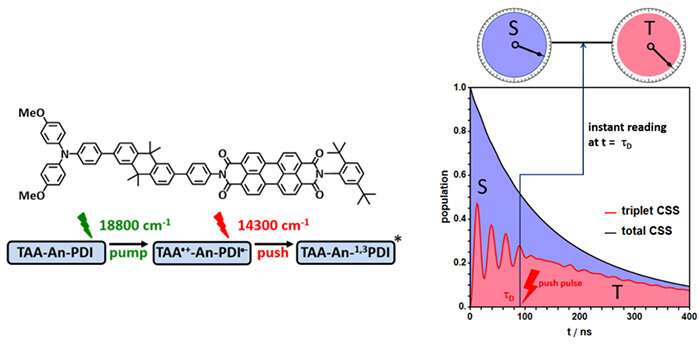The change between singlet and triplet states of electron pairs in charge-separated states plays an important role in nature. Presumably, the compass of migratory birds can also be explained by the influence of the earth’s magnetic field on the magnetic interplay between these two spin states.
Until now, this quantum process could not be directly followed optically. A research collaboration headed by chemistry professors Ulrich Steiner of the University of Konstanz and Christoph Lambert of the University of Würzburg has now presented a method in the scientific journal Science, the pump-push-pulse technique, which for the first time allows the temporal course of the singlet/triplet settings to be determined optically. This opens up new avenues, for example in the field of organic solar cells, but also for qubits in quantum computers.
Light energy raises an electron to a higher energy level
Normally, electrons in a molecule occupy the quantum-theoretically possible orbits in pairs. Here, the property of the electrons’ intrinsic angular momentum, their so-called spin, is of decisive importance.
According to the Pauli principle of quantum theory, two electrons can only run on the same path if their spin is antiparallel. If one electron spins clockwise, the other must spin anticlockwise. In the molecular ground state, all electron spins are usually paired.
By excitation with light, a single electron is released from the pair constellation and lifted to an energetically higher level, where it alone occupies a free orbit. From here, it can then jump to a free orbit in a suitable neighboring molecule.
The result is a photo-induced electron transfer. The two separated electrons can now change their spin setting independently of each other through magnetic interaction with their surroundings, as they are no longer constrained by the Pauli principle.
The two separated electrons form a radical pair
Such a charge separation by photo-induced electron transfer also takes place, for example, in photosynthesis.
The energy of the transferred electron decreases only slightly during this step, so that most of the electronic energy initially absorbed by the light excitation is still retained. This original excitation energy is thus stored in chemical form. The charge-separated state with the two separated electrons is also called a radical pair in chemistry.
If the spins of the two separated electrons are aligned in parallel, it is called a triplet state; if they are aligned antiparallel, it is called a singlet state of the radical pair. Due to the free individual evolution of the two spins, the spin state of the radical pair alternates back and forth between singlet and triplet states. Since energetically there is not much difference between these spin alignments, they could not be distinguished optically until now.
Energy stabilization of the radical pair can be achieved by the radical electron jumping back from the acceptor molecule to the donor molecule, thus returning to the original singlet state with the release of heat. However, in order to pair up with the original partner electron at the donor site, its spin must have remained opposite to that of the partner electron, which is not necessarily the case due to a possible spin reorientation in the meantime. If it currently has a different spin setting, it cannot return to its original orbit, but it can also release energy by hopping to another, still free, lower orbit at the acceptor site.
The thereby formed triplet product at the acceptor can be optically distinguished from the singlet product at the donor.
Radical pair as a model for qubits and the magnetic field sensor of migratory birds
The phase in which the radical pairs oscillate between the singlet and triplet states is of particular interest in many respects.
Since it is a quantum mechanically controlled coherent motion, it can in principle be controlled, for example, by an external magnetic field. Such motions are used e.g. in physics to implement quantum computers.
“Our radical pair can serve as a model for qubits, as they are present as elements in quantum computers, or for understanding the function of radical pairs in the biological compass of migratory birds mentioned at the beginning. For such reasons, it is of interest to know how the spin is currently positioned in this process,” says Ulrich Steiner, who conducts research on photokinetics and spin chemistry in Constance.
Pump-push technique enables determining the singlet/triplet settings
In Christoph Lambert’s laboratory in Würzburg, with the magnetic-field-dependent pump-push technique an experimental method was developed, with which it is possible for the first time to read out the singlet/triplet settings at specific points in time in a specially synthesized donor-acceptor molecule.
First, the electron transfer from the donor to the receiver molecule is initiated with a so-called pump-laser pulse. This creates the charge-separated state with singlet spin. The unpaired electron spins can now evolve in time.
After a certain time, a second laser pulse is applied. “This push laser pulse again transfers an electron back from the acceptor molecule to the donor molecule, whereby the second laser pulse forces the system to immediately make the decision between triplet or singlet product formation, for which the radical pair would normally take several spin oscillation periods,” says Ulrich Steiner, who, together with his Russian colleague, has substantiated the interpretation of the experiments by quantum theoretical model calculations.
In this way, it is possible to take snapshots of the spin state of the radical pair at different times and prove the periodic transformation of singlet and triplet radical pairs.
More information:
David Mims et al, Readout of spin quantum beats in a charge-separated radical pair by pump-push spectroscopy, Science (2021). DOI: 10.1126/science.abl4254
Provided by
Universität Würzburg
Citation:
Optical examination of the change between singlet and triplet states of electron pairs in charge-separated states (2021, December 23)



